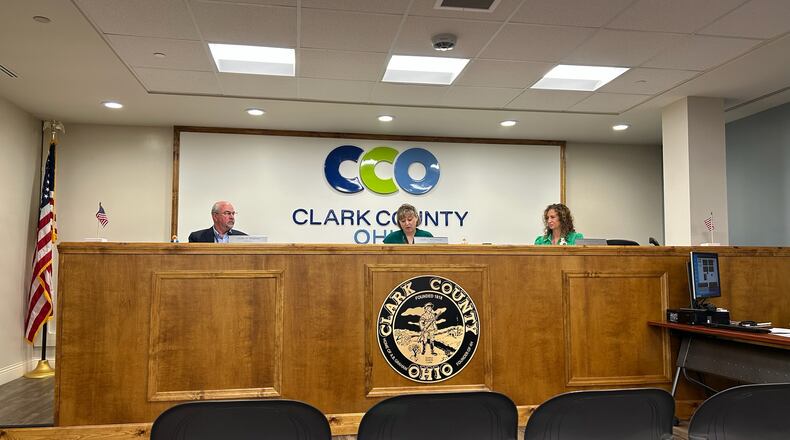“These decisions are not taken lightly, no matter what it is. If I would not want it near me or anybody that I care about, I would not vote to put it near anybody else ever,” commission president Sasha Rittenhouse said during Wednesday’s commissioners’ meeting.
“I always think, would I want to live there? Would I be okay with my mom, my kids, my grandma, anybody living next to these facilities? I would never vote to put something somewhere that I would not be willing to live next to it ever,” Rittenhouse said.
At a recent commissioners’ meeting, county leaders answered questions and talked about the need for the facility and went over details of the site selection process.
A 20-year, 0.5% sales tax increase will be on the November ballot for the construction and operation of a new detention facility.
Costs for a new facility are estimated at $100 million. Project costs include $77 million in construction costs, $16.5 million for professional services (architects, project management, etc.), a $4.1 million contingency fund and $2.3 million for site acquisition and preparation.
In August, commissioners approved a resolution to authorize an agreement to purchase four parcels of land from Allen C. Armstrong in the 2600 block of South Limestone Street in the amount of $1 million, plus closing costs not to exceed $100,000.
Concerns about location
Resident Dan Freeman said he recognizes a new jail is needed but is concerned with the proposed location and how that decision was handled.
“I recognize that the jail facility is an issue ... But the way that the process has unfolded has concerned me and many of my neighbors,” he said. “We’re not asking you necessarily to stop progress ... I just want some transparency and clarity.”
Some of those concerns include how the proposed detention center would border neighborhoods, schools and churches. There has been no detailed information on the site selection process, and no site alternatives have been mentioned.
In a letter to the editor regarding the jail site, Freeman urged commissioners to host a town hall with microphones and a recorded Q&A, publish the full site selection process — including all locations considered and the criteria used — pause any site-related actions until the meeting is held and materials are released, and outline mitigation measures such as buffers and a neighborhood impact fund if the Limestone Street site remains under consideration.
An online petition that is in favor of the county choosing a new location was started and has more than 150 signatures.
Several other residents agreed with Freeman, saying the commissioners need to have a town hall meeting for people to get more information and have their questions answered.
Commissioners said they are fine with having a town hall meeting. They feel they’ve been transparent with the information they can give and are always willing to talk on the phone or answer emailed questions, the commissioners said, but added that a town hall may be more useful at a later time.
Considerations county leaders had when looking at locations
Sheriff Chris Clark and commissioners said they looked at a variety of different sites.
Some of the locations include a Brownfield site at Kenton and Burt streets that had operational concerns; the Ohio Edison plant on the west end that is under a flood plain; a few spots on Leffel Lane that were too expensive, not for sale or had logistical issues; places by the fairgrounds that weren’t for sale or were outside of the price range; spots on the east end that would increase response times; and spots outside of the city that would require annexation.
There are always limiting factors to any location as well as a lot of criteria, according to Commissioner Melanie Flax Wilt.
“It seemed like that this was the one with the least limiting factors,” she said. “One of the things that this location does provide that none of the others that we looked at provided is the really nice highway access, but also the ability to set back so much because it’s three times the size of the parcel that would be needed to accommodate a modern facility.”
Clark said they were looking for something that had a minimum of 20 acres to allow for future expansion, was close enough to the highway to decrease response times, and allowed the facility to be offset and away from the public so the county would not have issues with people coming up to the jail.
“(There) were spots that we could potentially put the facility there, but they weren’t on the market and the people who own them weren’t interested in selling them,” Clark said. “We’re trying to be responsible with taxpayer dollars. The property that we ended up with ended up being the least expensive property and the best bang for your buck that we came across of the viable properties that we could negotiate a price on.”
Transparency
Flax Wilt spoke about the public’s concern about transparency, explaining that the commission is not permitted to discuss property purchases in a public setting while negotiations are taking place.
She said getting to the point of a letter of intent is when the conversation could become public.
“I know at that point it feels like it’s too late to get the public’s input, and I understand that, (but) that’s the way that we have to do that in order to follow the proper ethics. It’s not that we don’t want to hear from people, but we did go through a painstaking process of trying to think of everything and what the best overall approach was for the community as a whole,” she said.
Clark reiterated they have consultants helping them along the way in the process to make sure they’re “looking at things the way we need to be looking at things and the projections are done the correct way” because they’ve never built a new jail before.
About the Author


